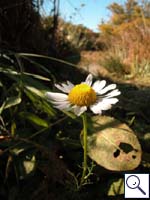|
||||||
|
TRIPLEUROSPERMUM. Mayweeds [Asteraceae] |
|
|
Two species of Tripleurospermum are recorded in Britain, the native Scentless Mayweed (T. inodorum) and Sea Mayweed (T. maritimum). The BSBI provide a downloadable plant crib for Tripleurospermum. Three or four British miners are recorded on Tripleurospermum. Elsewhere the agromyzid Napomyzxa lateralis is recorded boring stems of Tripleurospermum. A key to the European miners recorded on Matricaria including Tripleurospermum is provided in Bladmineerders van Europa. |
 Scentless Mayweed Tripleurospermum maritimum x inodora |
Key for the identification of the known mines of British |
| 1# > ? Leaf miner: Details unknown. |
|
1a > Stem-miner: A narrow, inconspicuous stem mine. Pupation at the end of the mine (Spencer, 1976: 64). Fine, upper- or lower-surface corridor, ending in a thick vein. From there the mine extends finally to the rind of the stem. There also the pupation takes place, usually not far from the root collar. Mines in the stem rind often are conspicuous through a red discoloration. |
|
Ophiomyia curvipalpis (Zetterstedt, 1848) [Diptera: Agromyzidae]. |
1b > Leaf-miner: Mine linear, whitish, both upper and lower surface. Pupation internal, at the end of the mine with the anterior spiracles projecting through the epidermis (Spencer, 1976: 433). Upper-surface, less often lower-surface corridor. Frass in isolated grains. Pupation within the mine, usually in a lower-surface puparial chamber. A long whitish upper surface corridor, which eventually goes lower surface. |
|
Chromatomyia
horticola (Goureau, 1851) [Diptera: Agromyzidae] |
1c > Leaf-miner: A narrow linear mine, even in the finest subdivisions of the leaves (Spencer, 1972b: 77, as matricariae ; Spencer, 1976: 478). Very fine corridor, upper- or lower-surface, even in the narrowest leaf segments. The corridor may be up to 14 cm long (Sehgal, 1971a). Generally the corridor descends towards the leaf base. Frass in pearl chains of loose grains, hardly in strings. Pupation outside the mine. Very fine corridor, upper- or lower-surface, even in the narrowest leaf segments. The corridor may be up to 14 cm long (Sehgal, 1971a). Generally the corridor descends towards the leaf base. Frass in pearl chains of loose grains, hardly in strings. Pupation outside the mine. |
|
Phytomyza pullula Zetterstedt, 1848 [Diptera: Agromyzidae]. |
| Last updated 07-Jul-2019 Brian Pitkin | ||
